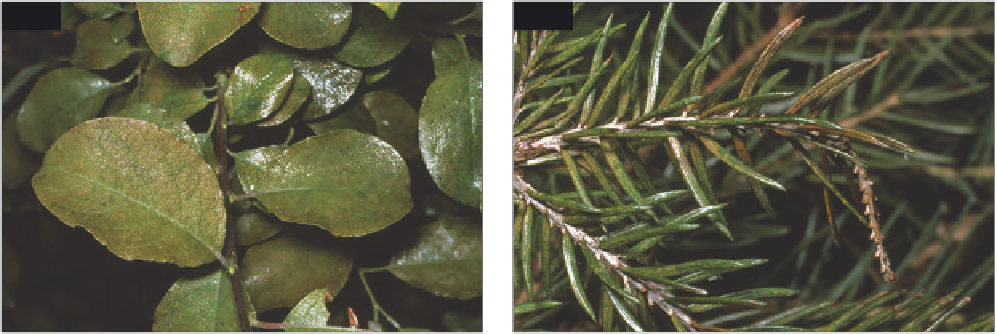Biology Reference
In-Depth Information
1131
1132
1131
Eotetranychus populi
damage to leaf of
Salix
.
1132
Conifer spinning mite (
Oligonychus ununguis
) damage
to needles of
Picea
.
Oligonychus ununguis
(Jacobi) (
1132
)
Conifer spinning mite
A generally common and virtually worldwide pest of
conifers; most important on young spruce (
Picea
) trees.
Present throughout Europe.
sometimes aggregate in vast numbers amongst webbing
on the trunks and main branches of host trees.
DAMAGE
The mites cause noticeable bronzing of leaves, spoiling
the appearance of specimen trees; they also cause
premature defoliation, heavily infested leaves
shrivelling and dying. Host trees are sometimes
disfigured by glistening sheets of polythene-like
webbing.
DESCRIPTION
Adult:
0.2-0.5 mm long; dark green or orange to
brownish or blackish. Egg: greenish brown to orange-
red; spherical, with a dorsal spine (stipe).
Larva:
pinkish but soon turning greenish; 6-legged.
Nymph:
greenish; 8-legged.
Eotetranychus populi
(Koch) (
1131
)
Associated with broad-leaved willows such as grey
willow (
Salix cinerea
) and various species of poplar
(
Populus
), including aspen (
P. tremula
). Present as a
pest in various parts of Europe, including England; also
found in North America. The adults overwinter under
loose bark or within bark crevices on the trunks and
branches of host trees, and emerge in the spring. They
then invade the underside of the young leaves and soon
deposit eggs. The mites often occur on young sucker
growth, individuals sheltering amongst the leaf hairs
and beneath silken webs. There are several generations
annually, and breeding continues so long as conditions
remain favourable. Infested leaves become noticeably
discoloured and also tend to curl, but damage is of
significance only on young trees.
LIFE HISTORY
Eggs overwintering on the shoots hatch from April or
early May onwards. Mites then feed for 2-3 weeks,
passing through a larval and two nymphal stages before
becoming adults. There are several generations
annually, usually up to five. The mites produce
considerable quantities of webbing. Summer eggs are
laid on the shoots and needles; winter eggs are usually
deposited close to the base of the needles.
DAMAGE
Infested needles are noticeably discoloured, becoming
mottled and yellowish and eventually turning brown.
Affected needles may also fall prematurely, checking
shoot growth. Heavily affected shoots become curved
and develop with shortened internodes. Spruce
seedlings and transplants may be killed, particularly if
being raised in dry soil conditions.

Search WWH ::

Custom Search